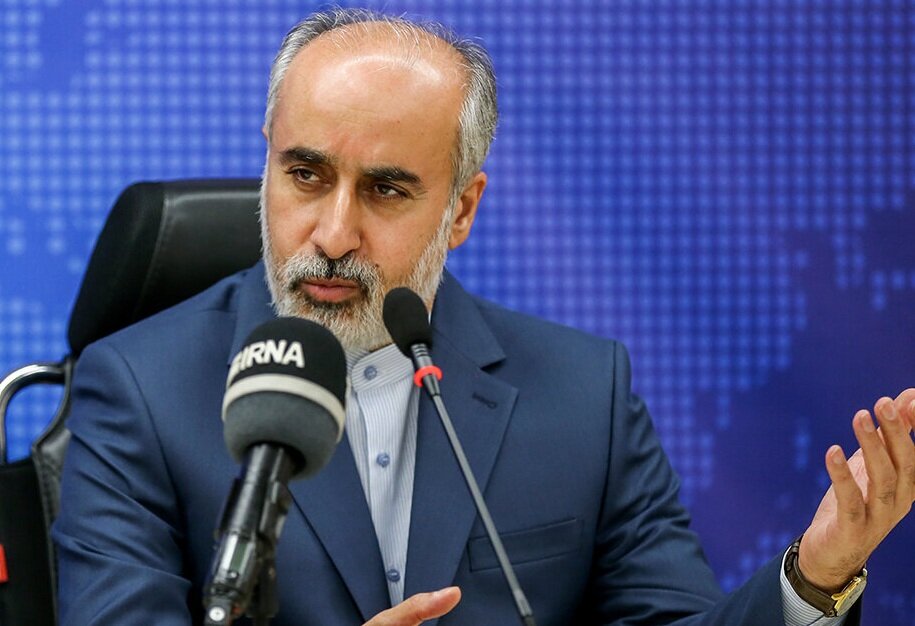
Foreign Ministry Spokesman Nasser Kana’ani speaks to the Islamic Republic News Agency in a November 2022 file photo.
“Efforts will be made to reopen and activate our country’s diplomatic representations before the annual Hajj.”
On 10 March 2023, regional rivals Iran and Saudi Arabia announced a deal to restore diplomatic relations for the first time in more than seven years. On 6 April 2023, Iranian Foreign Minister Hossein Amir Abdollahian and his Saudi counterpart, Prince Faisal bin Farhan Al Saud, met in Beijing to discuss the technicalities of resuming ties. According to the excerpted article from the Iran-based Hamshahri newspaper, these diplomatic efforts are taking place in earnest to normalize relations before the Hajj, which begins 26 June 2023.[i] Iran-Saudi ties have long been fraught. While ethnic tension between the two Middle East regional powers predates Iran’s Islamic Revolution, sectarian and ideological differences in the post-1979 period created significantly more hostility.[ii] Both countries accuse the other of supporting terrorist groups targeting the other.[iii] So, while the restoration of diplomatic relations may appear straightforward, Iran’s track record breeds suspicion, especially regarding the Hajj. In 1986, the head of the predecessor to the Quds Force, sought to infiltrate saboteurs into Mecca under cover of the Hajj to unleash a bombing campaign. The following year, clashes erupted between Iranian demonstrators and Saudi security forces, leading to the deaths of more than 400 pilgrims. Despite Saudi Crown Prince Muhammad bin Salman’s willingness to reconcile with Iran, Saudi security forces and intelligence will tread carefully, especially regarding the size of the mission and the freedoms Iranian diplomats might enjoy inside the Kingdom. During the 1986 incident, hardline ideologues within Iran’s security services ignored the Iranian government’s desire to break out of its isolation. Almost four decades later, it remains to be seen if the same dynamics are at play, especially as the Islamic Revolutionary Guard Corps do not fall under the authority of either President Ebrahim Raisi or Foreign Minister Abdollahian.
Source:
“Talash baraye Rahandazi Saferat-e Iran dar Arabistan qabl az Ayam-e Hajj (The Struggle to Set Up an Iranian Embassy in Saudi Arabia before the Hajj),” Hamshahri (mass circulation general newspaper), 12 April 2023. https://www.hamshahrionline.ir/news/753453
Foreign Ministry Spokesman Nasser Kana’ani said that an Iranian technical delegation arrived in Riyadh on Wednesday [April 12] at noon in a new step toward the implementation of the agreement between the Islamic Republic of Iran and Saudi Arabia to resume formal relations and diplomatic activities of political and consular representations of the two countries. Saudi officials welcomed the delegation.
The spokesman added that the Iranian delegation divided into two working groups to take the necessary measures to set up the embassy and consulate general in Riyadh and Jeddah respectively and also to discuss reestablishment of a permanent representation of the Islamic Republic of Iran to the [Jeddah-based] Organization of Islamic Cooperation.
The Foreign Ministry spokesman also added that the Saudi technical delegation, which arrived in Iran on Saturday [April 8, 2022], will leave for Mashhad tomorrow [April 13, 2022].“Efforts will be made to reopen and activate our country’s diplomatic representations before the annual Hajj,” the spokesman added.
Notes:
[i] Within the United States, much of the ensuing coverage and commentary focuses on China’s role as diplomatic broker, but Iranian discussion largely focuses on the technicalities and timeframe for resuming its diplomatic missions in the Kingdom.
[ii] Saudi Arabia was among Iraq’s most generous financial backers during the 1980-88 Iran-Iraq War. After clashes at the Hajj in 1987, Saudi Arabia cut diplomatic ties with Iran, a freeze that lasted close to four years. During the 1990s, there was a brief rapprochement, but tensions renewed after the 2003 U.S.-led ouster of Saddam Hussein as Iranian-backed militias grew more powerful in Iraq at the expense of the country’s Sunni Arabs. In 2012, protests that Saudi authorities accused Iran of instigating wracked Saudi Arabia’s Shiite-dominated Eastern Province. Saudi Arabia responded with brute force, killing dozens and arrested Sheikh Nimr al-Nimr, Saudi Arabia’s top Shiite scholar, who Saudi Arabia later executed. For more on the dynamics at the time, see: Michael Rubin, “Iran Demands Release of Nigerian Shi’ite Cleric” OE Watch, September 2016. https://community.apan.org/wg/tradoc-g2/fmso/m/oe-watch-past-issues/195361/download
[iii] For example, see: Michael Rubin, “Iran’s Prosecution of Arab Separatist Highlights Supposed Saudi Ties” OE Watch, 3-2022. https://community.apan.org/wg/tradoc-g2/fmso/m/oe-watch-past-issues/407738/download
Image Information:
Image: Foreign Ministry Spokesman Nasser Kana’ani speaks to the Islamic Republic News Agency in a November 2022 file photo.
Source: https://media.hamshahrionline.ir/d/2022/11/08/4/4752193.jpg?ts=1667935844000
Attribution: Islamic Republic News Agency




